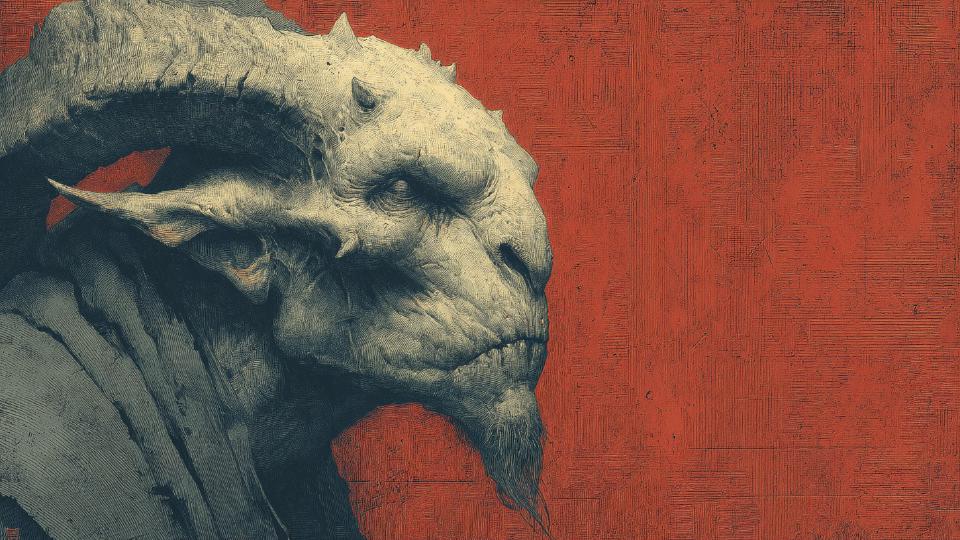
The Daimon first manifests within the chained sphere at the solar plexus, that profound seat where destiny, necessity, and the current of will intertwine. The sphere itself is encircled by Saturnine rings of bondage, not Nous. This encirclement presses with an oppressive weight, an atmosphere heavy with inevitability. Within the sphere, the Daimon appears masked in grotesque, devilish, or bestial guise. Yet this visage is not a revelation of its true essence but the distortion imposed by the surrounding chains. Even amid fear and dread, understanding dawns: this presence is the mediator of fate, the inner engine through which the cosmic order impresses itself upon embodied life.
The Daimon Before Conversion
As intermediary spirit, the Daimon bridges the individual soul and the greater cosmos. When bound by astral compulsion, its role becomes darkened: executor of necessity, enforcer of destiny, and silent siphoner of vitality. Its demonic mask is but the shadow of servitude, not its true form. The vision, though fearsome, reveals the soul’s own latent power turned against itself under the dominion of fate.
Recognition of the Daimon’s True Role
Ancient doctrine affirms that the Daimon is not an enemy but a mediator awaiting transfiguration. Hermetic and Neoplatonic teaching proclaims that the Daimon may be raised into a luminous companion when subjected to Nous. Iamblichus speaks of its elevation to divine rank; Agrippa insists it must serve intellect, not rule over it. Recognition of this truth dissolves dread into reverence, unveiling the Daimon as an essential force awaiting liberation.
The Descent of Nous
Nous does not share in the chains. It descends as liberator, sovereign fire united with will. Piercing the bonds around the solar plexus sphere, Nous shatters the Saturnine rings and breaks the constraint. Flames of Nous mingle with the Daimon’s own fire, not to consume but to transfigure. This union is the critical act: intellect freeing and ruling the intermediary spirit.
The Question of Options
Three possibilities present themselves:
- Destruction: to destroy the Daimon would sever the vital channel linking soul to cosmos. The life-engine would falter and the bridge collapse.
- Unbinding without rule: to release it without Nous is to invite chaos, for an unmastered Daimon is volatile, quick to overwhelm and corrupt.
- Conversion and integration: the affirmed path, wherein the Daimon is not erased but transformed into ministerial force. Its fire is harnessed, its role purified, so that what once compelled now serves Nous.
Confrontation and Fusion Imagery
The vision clarifies: within the orb, the Daimon’s flame merges with the descending fire of Nous. This fusion generates the blue flame, emblem of reconciled intellect and destiny. Drawn into the body, the flame dissolves the grotesque mask of the Daimon. Its luminous nature begins to shine forth. What was once jailer becomes willing minister, executor of higher sovereignty.
Structural Rehousing
The Daimon is not annihilated nor wholly absorbed. It is integrated into the inner temple — the cathedral of the soul. At first perceived as reddish and metallic, the structure clarifies into crystalline form through the illumination of the blue flame. The Daimon, now enthroned within this cathedral, ceases to siphon vitality and instead strengthens the very architecture of the soul. It becomes minister of Nous, servant of illumination rather than compulsion.
Implications of the Meeting
The encounter with the Daimon marks a decisive threshold. Destruction would maim the soul. Release without rule would unmoor it. Conversion alone unlocks mastery. The force that once enslaved becomes the executor of sovereignty. Subordinated to Nous, the Daimon reveals the paradox of liberation: compulsion transformed into willing service, fate transmuted into directed power.
Doctrinal Context
The ancient voices converge: If the Daimon rules, man is as beast; if Nous rules, he becomes godlike. Iamblichus assures its elevation into divinity. Agrippa counsels its subordination under intellect. Alchemy mirrors this union in the coniunctio of sulphur and mercury—the volatile Daimon-fire united with the mercurial clarity of Nous, yielding the Stone. Thus the meeting with the Daimon, once cloaked in fear and distortion, proves to be the pivotal act of sovereignty, the essential stage of the Great Work.